Experience the vibrant Holi Festival, a celebration of spring and unity. Discover the significance of colors and rituals, learn photography tips for capturing the festivities, and explore eco-friendly practices for a sustainable celebration. Engage in the communal spirit that fosters connections and lasting memories during this colorful event.
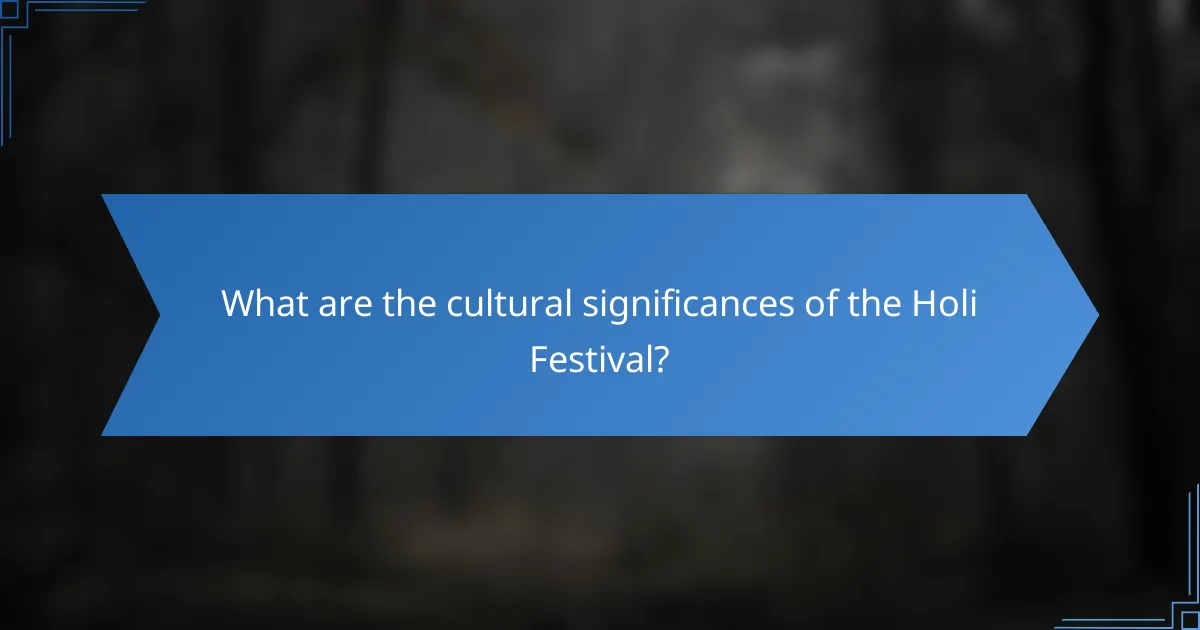
What are the cultural significances of the Holi Festival?
The Holi Festival holds deep cultural significance, symbolising the arrival of spring and the triumph of good over evil. This vibrant celebration promotes unity, forgiveness, and the renewal of relationships. Participants throw coloured powders, which represent joy and the diversity of life. Holi encourages communal harmony, as people from various backgrounds come together to celebrate. Additionally, it fosters creativity through artistic expressions like music, dance, and photography, capturing the essence of this colorful event.
How do different regions celebrate Holi uniquely?
Different regions celebrate Holi with unique traditions and practices. In North India, vibrant colours and water play dominate celebrations, especially in cities like Mathura and Vrindavan. West Bengal features the traditional dance of “Holi” with cultural performances and music. In South India, the festival is often marked by special prayers and rituals, emphasising spiritual significance. In Maharashtra, people celebrate with a mix of colours and festive foods, showcasing local culinary delights. Each region’s unique attributes reflect its cultural heritage, making Holi a diverse and colourful festival across India.
What rituals are essential to the Holi celebration?
Essential rituals of the Holi celebration include the Holika Dahan bonfire, throwing coloured powders, and communal feasting. These practices symbolise the victory of good over evil and foster community spirit. Holika Dahan, performed the night before Holi, involves burning an effigy of Holika, representing the triumph of devotion. The next day, participants joyfully throw vibrant powders, known as gulal, celebrating love and unity. Families and friends gather for festive meals, enhancing connections and creating lasting memories.

Why do colours play a vital role in Holi?
Colours are essential in Holi, symbolising joy, love, and the arrival of spring. Each colour holds unique meanings; for example, red represents love, yellow signifies knowledge, and green symbolizes new beginnings. The vibrant hues enhance the festive atmosphere, fostering unity and celebration among participants. Moreover, colours in Holi promote emotional expression and creativity, making the festival a visual delight.
What are the meanings behind the various colours used?
The colours of the Holi Festival symbolize various meanings. Red signifies love and fertility, yellow represents knowledge and learning, blue embodies the divine and protection, green stands for harmony and new beginnings, and orange symbolizes the warmth of life. Each colour contributes to the vibrant atmosphere and cultural significance of this joyous celebration.
How do colour powders differ across cultures?
Colour powders used in the Holi Festival vary significantly across cultures, reflecting local traditions and meanings. In India, vibrant colours symbolize joy and the arrival of spring, while in Nepal, they may represent religious significance and community bonding. Other cultures may use colour powders in festivals to signify renewal or harvest celebrations, often incorporating unique local ingredients. The choice of colours can also differ, with some regions favouring natural dyes and others opting for synthetic ones. These variations highlight the rich tapestry of cultural expressions surrounding colour powders in celebrations worldwide.
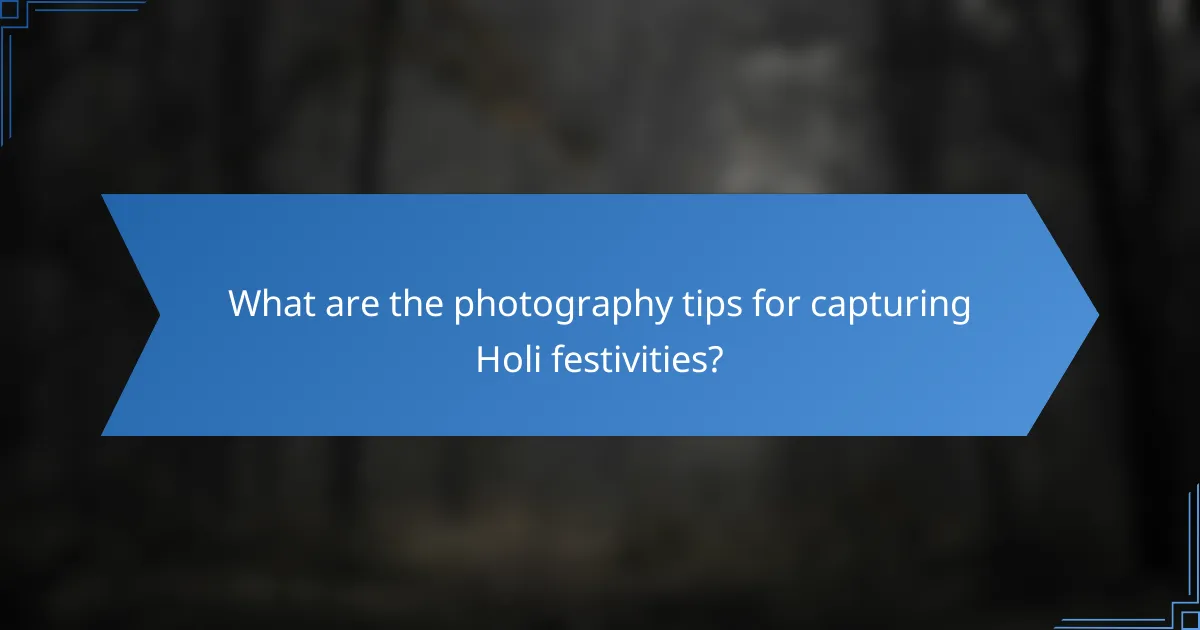
What are the photography tips for capturing Holi festivities?
To capture the vibrant Holi festivities effectively, focus on timing, composition, and equipment. Early morning light enhances colours, while candid shots of participants convey the festival’s spirit. Use a fast shutter speed to freeze action and prevent motion blur from playful colour throws. A wide-angle lens captures large groups and the festive atmosphere. Experiment with different angles to highlight the vibrant colours and rituals.
How to prepare your camera for the Holi environment?
To prepare your camera for the Holi environment, ensure it is protected from colours and moisture. Use a weather-sealed camera bag and lens covers. Set your camera to a fast shutter speed to capture dynamic moments. Adjust the ISO for low light conditions, as festivities often occur during the day. Consider using a polarising filter to enhance colours and reduce glare. Regularly clean your gear to maintain performance and avoid damage from powders.
Which techniques enhance colour vibrancy in photos?
To enhance colour vibrancy in photos, utilise techniques such as adjusting saturation, using polarising filters, and employing proper lighting. These methods significantly improve the richness and clarity of colours captured during events like the Holi Festival.
For example, increasing saturation enhances the intensity of colours, while polarising filters reduce glare and reflections, making colours appear more vivid. Proper lighting, especially natural light, can further accentuate the vibrancy of colours, creating stunning images.
What are the best angles and compositions for Holi photography?
To capture the essence of Holi photography, focus on vibrant angles and compositions. Use low angles to emphasise colours and expressions. Capture wide shots to include crowds and festivities. Close-ups of coloured powders highlight detail. Experiment with framing, such as using natural elements to enhance the scene. Consider backlighting to create a glowing effect with colours.
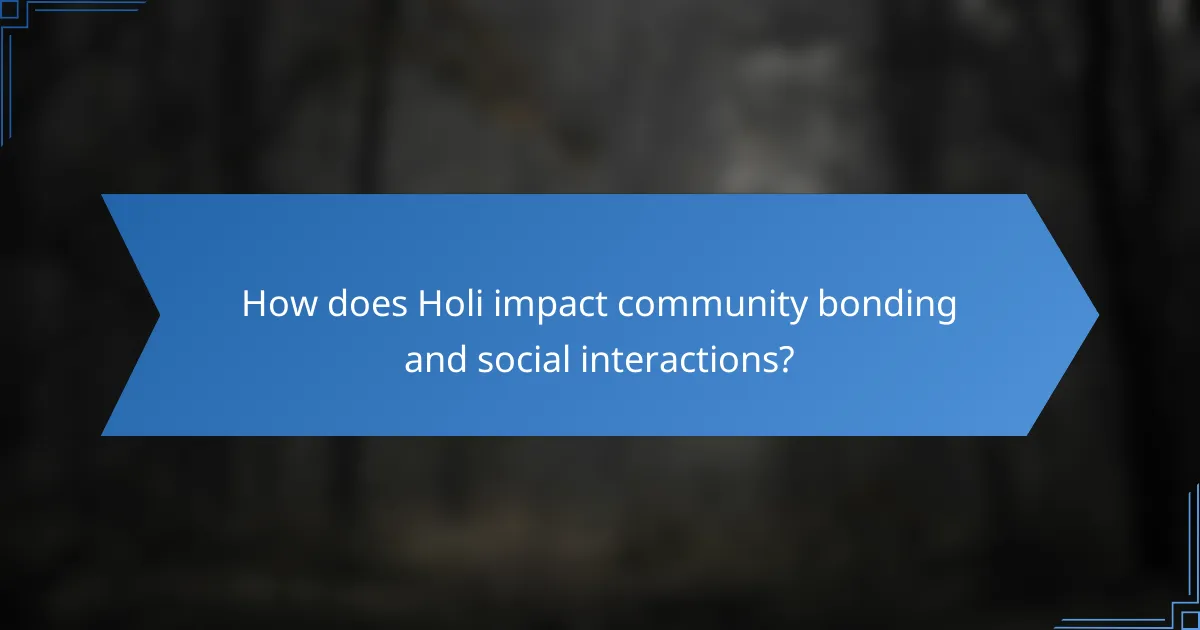
How does Holi impact community bonding and social interactions?
Holi enhances community bonding and social interactions through shared celebrations and colourful festivities. Participants engage in playful exchanges of colours, fostering connections among diverse groups. This festival encourages inclusivity, breaking down social barriers. Research shows that communal activities during Holi strengthen relationships and promote harmony, creating lasting memories and friendships.
What role does music and dance play during Holi?
Music and dance are central to Holi, enhancing the festival’s joyous atmosphere. They foster community bonding and celebrate the arrival of spring. Traditional songs and vibrant dance forms like Bhangra and Garba create an immersive experience. Participants express happiness and unity through rhythmic movements and melodies, making Holi a lively celebration.
How do families and friends come together during the festival?
Families and friends come together during the Holi Festival to celebrate unity and joy. They participate in vibrant colour throwing, share festive meals, and engage in traditional rituals. This festival fosters connection, as people visit each other’s homes, exchange greetings, and strengthen bonds through shared experiences. The atmosphere is filled with laughter, music, and dance, creating lasting memories that highlight the spirit of togetherness.
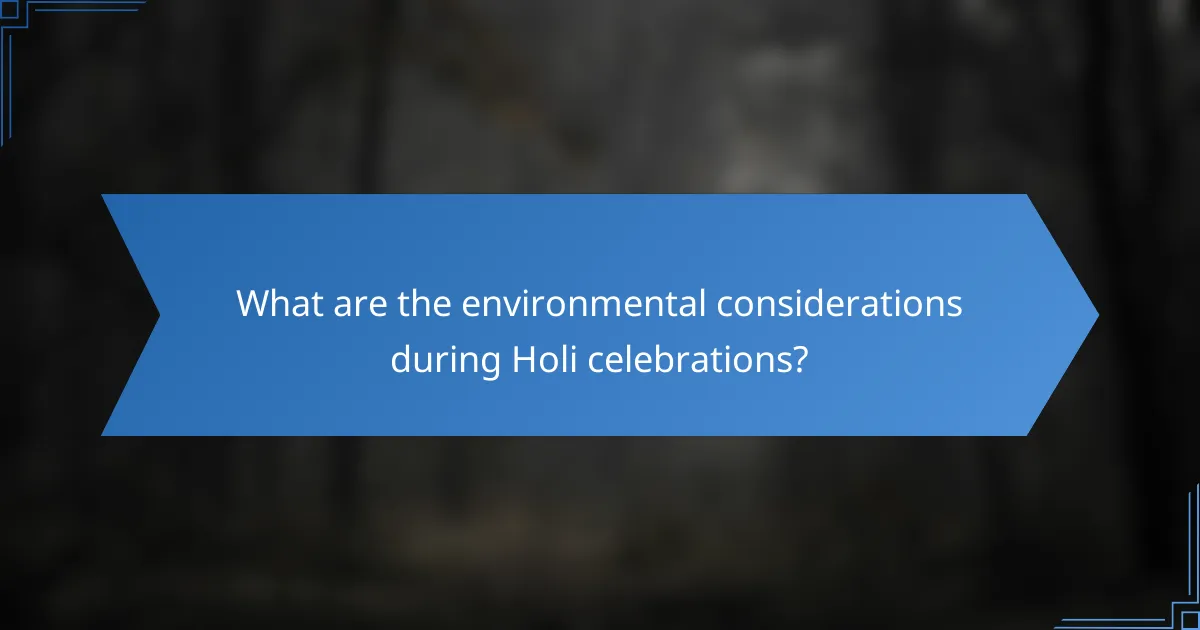
What are the environmental considerations during Holi celebrations?
Holi celebrations can impact the environment through pollution and waste. To mitigate these effects, consider eco-friendly colours, biodegradable materials, and waste management practices. Using natural dyes reduces chemical runoff, while promoting recycling minimizes litter. Additionally, encouraging water conservation during festivities helps preserve local water sources.
How can participants ensure eco-friendly practices?
Participants can ensure eco-friendly practices during the Holi Festival by using natural colours, minimising water waste, and promoting sustainable materials. To start, choose plant-based colours instead of synthetic ones, which are harmful to the environment. Additionally, consider organising dry Holi celebrations to reduce water usage. Encourage the use of biodegradable or reusable items for food and decorations. Lastly, educate attendees about the importance of cleaning up after the festivities to protect local ecosystems.
What are the health impacts of traditional Holi powders?
Traditional Holi powders can cause skin irritation, respiratory issues, and allergic reactions. These powders often contain synthetic dyes and chemicals, which can be harmful. Natural alternatives exist, such as turmeric and henna, which provide vibrant colours without adverse health impacts. Always opt for eco-friendly powders to minimise health risks.
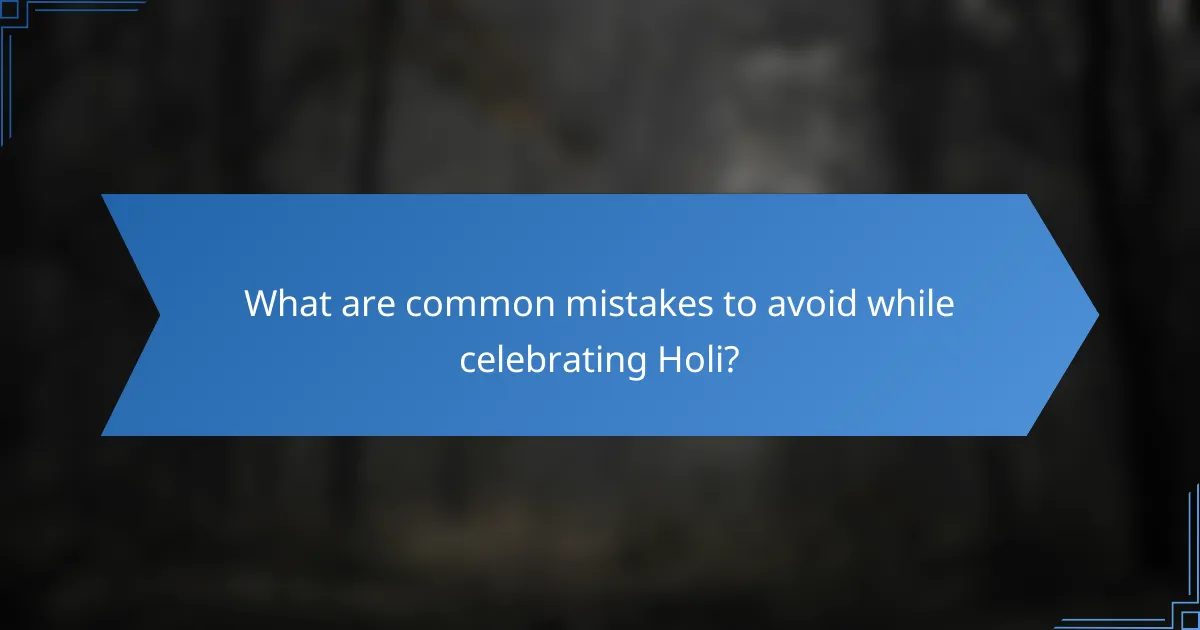
What are common mistakes to avoid while celebrating Holi?
To celebrate Holi successfully, avoid common mistakes such as using harmful colours, neglecting safety precautions, and disrespecting local customs. Prioritise eco-friendly colours to protect health and the environment. Always ensure a safe space for festivities to prevent accidents. Respect cultural traditions to enhance the celebration’s authenticity.
How to ensure safety during Holi festivities?
To ensure safety during Holi festivities, follow these essential tips. Wear protective clothing to cover your skin and eyes. Use natural colours to minimise skin irritation. Stay hydrated and avoid excessive sun exposure. Designate a safe area for celebrations to prevent accidents. Keep first aid supplies handy for minor injuries.
What are the etiquette guidelines for participating in Holi?
To participate in Holi respectfully, follow these etiquette guidelines: respect personal boundaries, avoid using harmful colours, and seek permission before throwing colours. Dress in old clothes, as they may get stained, and protect your skin and hair with oil. Be mindful of others’ comfort levels with participation.
What are the best practices for photographing Holi celebrations?
To photograph Holi celebrations effectively, focus on vibrant colours, dynamic moments, and cultural rituals. Use a fast shutter speed to capture action and avoid motion blur. Consider shooting during golden hour for soft lighting, enhancing the colours. Use a wide-angle lens to encompass large crowds and festivities. Protect your camera from colour powders with lens filters and waterproof covers. Engage with participants for candid shots, capturing the joy and spirit of the festival.